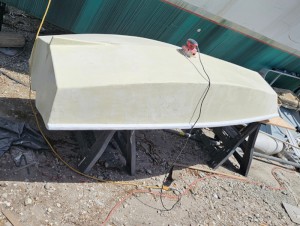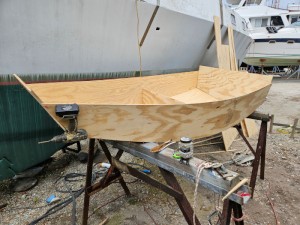Kaimusailing
s/v Kaimu Wharram Catamaran
| Vessel Name: | Kaimu |
| Vessel Make/Model: | Wharram Custom |
| Hailing Port: | Norwalk, CT |
| Crew: | Andy and the Kaimu Crew |
| About: | Sailors in the Baltimore, Annapolis, DC area. |
17 April 2024 | St Marys, GA
Dinghy Skeg
I was suffering with what seemed like a cold and also had allergy symptoms. I awoke and felt fine. The green pollen that was coating everything was gone. Maybe it will return.
07 April 2024 | St. Marys, GA
Clammy Hands
Items came in from TEMU, the Chinese cut rate retailer. One was a nice little drone that cost about twelve and a half dollars. It looked like an easy thing to play with while I coughed and sneezed. I was fighting a summer cold, even though it is not summer elsewhere, it seems like it here. A nice [...]
02 April 2024 | St. Marys, GA
Sun Doggie
After laminating the cedar strips onto the gunwales of the dinghy I found the screws I used wouldn’t come out. The epoxy had seized them. The screw heads were stripped so I cut a straight slot in the heads with the cut off wheel. The cedar smoked when the screw heads got red hot. I could remove [...]
21 March 2024 | St. Marys, GA
Just Add Water
The rainy weekend started off with overcast and fog but no rain. It looked like I might be able to get something done on the D4 dinghy. I wanted to change the bow seat which is really the bow deck. The sailing option uses the deck to hold the freestanding mast. I didn’t like how the deck looked, [...]
01 March 2024 | St. Marys, GA
D4 Dinghy Alternative Seats
The rain event was more wind than rain, strong winds with gusts up to 44 mph. We drove into town to see what the harbor was like. There was a small sailboat that had dragged anchor and was sitting close to shore. The tide was out. We left and played with Bleu at Notter’s Pond.
23 February 2024 | St. Marys, GA
D4 Inside Seams
Day two of the dinghy build started out with me finishing wiring the hull bottoms together on the centerline of the bottom panels. This was much easier than the wiring of the chine edges of the bottom panels and the side panels.
Masted

.
The outhaul was cut into two lines, one from the block with becket out the rear of the boom, the other from the becket, around the single block on a strop, then around the block with becket, and finally coming out the gooseneck end of the boom around a sheave and through a rope clutch. There are 4 rope clutches, one for each of the booms internal lines. Messenger twine was run through the boom for the remaining 3 lines and then the gooseneck end fitting was blind riveted back in place with stainless 3/16“ rivets. The boom was now ready to go on board.
.
I rolled the mast in its carrier down to the travel lift well and parked it with the boom for installation on Kaimu. The high tide would be at 8:30 in the morning. The travel lift was parked at its well with one of its tires and wheels disassembled. It would have to move into the yard so that the crane could come in to hoist the mast.
.
When I was on board later I started Kaimu’s engine and brought the main anchor and its chain on board. Then I secured the chain and released the windlass’ clutch which enabled the drum to turn while the gypsy was stopped with the chain.
.
In the morning I brought the spare anchor and its line in using the windlass’ drum. I always run the engine when using the windlass, it runs off of the engine battery. We were now underway with all the anchors pulled up. It was approaching high tide, so Kaimu could go straight to the trave lift well and not have to do the big U-turn down to the shrimp docks, then come North to the well.
.
When I got to the well I tied a line from the port bow to the downstream bumper which had a cleat on top and was faced with strips of cushion. I then tied a line onto a tug that was tied up on that side of the well, and I began backing down on the engine. The line to the tug kept Kaimu from going astern, but slowly she began to tuck her port stern in toward a piling North of the upstream bumper. When she was very close to the piling I passed a line around it from port stern and brought it back on board and tightened it. Now Kaimu was securely moored at the travel lift well, a tight fit.
.
The boatyard personnel were working on a tire and wheel of the travel lift. These are large truck tires with a rim that comes apart, but stays put when brought up to full pressure, about 140 psi. While inflating the tire a fork lift was parked in front of the rim. The explanation was that if the rim failed it would fly all the way across the boatyard.
.
The crane was positioned and the mast was parked inland of the crane. A strap was wrapped around the mast and the mast was hoisted high over everything then lowered to the mast step on Kaimu’s deck. A number of problems came up. The worst was my calculations for the running backstays were way off. Fortunately they were too long. The inner forestay was too long, but I expected it to not be perfect. If it was we could shackle it to the eye on deck and not have to install a Stay-lok turnbuckly fitting. Another problem was the backstays were on the wrong side of the spreaders. We’d have to bring the mast back on shore to reroute the running backstays. The shackles for the triple blocks on the running backstays looked like they were 3/16“, but the eyes on the cable part of the running backstays were for 1/2“ pins. I had the 1/2“ pinned shackles. The little shackles would not fit around the larger shackles.
.
The boatyard personnel took a break while I installed a Stay-lok turnbuckle stud on the inner forestay. I found I could hammer the small shackles onto the large shackles. They looked funny together. The smaller shackles are the triple block manufacturers idea, sized to the working load of the block. The larger shackles are sized for the eyes on the swaged fittings on backstay cable. Of course the stay will never fail, just the blocks.
.
I cut the inner forestay where it was marked and I installed the Stay-lok stud, then threaded a turnbuckle onto the stud.
.
We made a third attempt to step the mast and when it was set up with the running backstays and inner forestay, the mast was raked too far aft. The personnel left to do other jobs while I stayed on board to terminate the upper shrouds and headstay. The rigger had gone aloft to mark the cables and retrieve the Stay-lok fittings that were pinned to tangs on the mast. He brought me a bucket of parts.
.
To take out the excess rake of the mast I shortened the headstay by 6 inches from his mark and lengthened the upper shrouds by 6 inches. Then I cut and installed the fittings called toggle jaws. I then hoisted the headstay with the genoa halyard and the two upper shrouds with the mainsheet tied to both of them with a 10 foot yoke. The tail ends of the halyard were tied onto the lifting ends so that I could haul them down after the cables were pinned to the mast.
.
When the rigger pinned the shrouds to the mast I released the running backstays and hauled on the staysail halyard which was attached to the inner forestay eye on deck. This brought the mast forward, standing straight up. The headstay was now pinned to the mast. Finally the VHF antenna and windex were mounted on the masthead.
.
After we secured I asked the boatyard owner, general manager, and chief crane operator what the bill was, he replied $200. Ridiculous. It should be more like $800, that would be a fair amount just for the crane. The rigger asked me if I could give him something for his time. Of course.
.
I went to the gas station restaurant with Radio Bill and we celebrated with dinner and a pitcher of draft beer. When we returned it was high tide, slack water. I carefully unmoored Kaimu from the piling and travel lift well and motored South toward the shrimp docks, then did a big U-turn North into the North River. A kayaker was watching Kaimu arrive at her anchorage as the sun was setting. Down went the anchor and Kaimu was snubbed on the spare anchor. The incoming tide current was still running a bit so the big catamaran slowly wheeled around to face downstream, South. The kayaker came over, name Jimmy, I had spoken with him a couple of times before. Nice conversation. I was exhausted, however, and I knew it would be a night of ibuprofen.
.
The next morning I adjusted the rigging to get the rake just about where I wanted it. I took the photo when I was shore. I can see Kaimu at anchor in the center of the photo, at the breezeway in the boatyard facing the anchorage.






